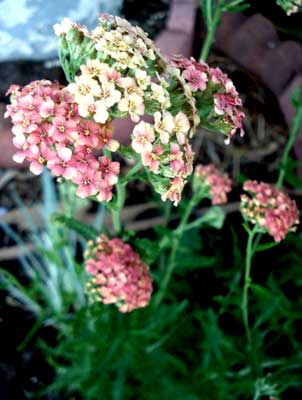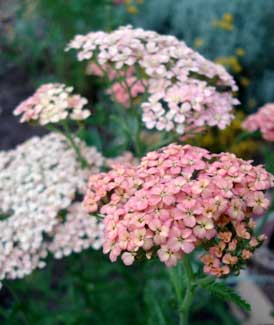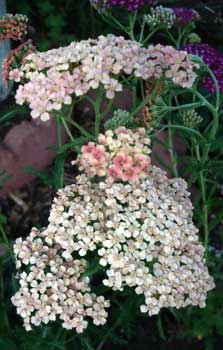
'Appleblossom'
aka, 'Apfelblute' Yarrow
"Under a grey sky, or at the gloamin',
the Yarrow wears a peculiarly wan aspect --
a look of sadness."
-Robert Borland,
Scotland, 1890
"How can I busk a winsome marrow
How lo'e him on the banks of Tweed
That slew my love on the braes of Yarrow
Yarrow fields, may never, never rain
Nor dew they tender blossoms cover
For there was basely slain my lover."
-William Hamilton
(1704-1754)
Scotland, 1890
(1704-1754)
 Milfoil, Achillea, or Yarrow has long been symbolic of Scottish melancholy -- generally a melancholy associated with warfare along the border with England, as in the valley of the Yarrow River.
Milfoil, Achillea, or Yarrow has long been symbolic of Scottish melancholy -- generally a melancholy associated with warfare along the border with England, as in the valley of the Yarrow River.
Whether the medicinal use of yarrow, allegedly as a cure for sorrow, arose from Scottish balladry, or is older than poetic allusion, is difficult to say, since it has no such value beyond the poetry.
Two-foot tall thinly leafed stems of 'Appleblossom' yarrow (Achillea millefolium 'Appleblossom') is crowned by large flat corymbs consisting of tiny blossoms, in sundry soft shades of pink fading into a dusty off-white.
 Bred in Germany, its actual name is 'Apfelblute,' rendered into English as one word, but occasionally as Apple Blossom. It's only rarely any taller than two feet, sometimes shorter, compared to many cultivars like 'Terra Cotta' that can grow to three feet. By right of its comparative compactness, 'Appleblossom' has tidier foliage than taller achilleas, & rarely lodges.
Bred in Germany, its actual name is 'Apfelblute,' rendered into English as one word, but occasionally as Apple Blossom. It's only rarely any taller than two feet, sometimes shorter, compared to many cultivars like 'Terra Cotta' that can grow to three feet. By right of its comparative compactness, 'Appleblossom' has tidier foliage than taller achilleas, & rarely lodges.
Applicable generalities about yarrows include hardiness in the xeriscape garden (though they do need some watering in the longest hottest days to look their best), easy for containers or rock-gardens, & attractive to butterflies & bees.
Plus it is as deer-resistent as perennials are ever apt to be, certainly cold-hardy to zone 4 & possiblly to zone 3, tightly clumped for the open garden, not aggressive toward other plants, & will hold its color if dried for dry flower arrangements.
'Appleblossom' flowers as early as May, more certainly by late June, & reflowers through September or until first frost. In colder zones it may flower only until July's end. It wants full sun, never too wet but regular watering its first year then increasingly drought-hardy. Excellent drainage is essential for all yarrows, so that raised beds are recommendable in areas of high rainfall.
They are ideal for "wild" gardens that need only moderate attention, & can be crowded meadow-style without injury as it is not a big feeder. When the clump has spread to a foot & a half or three feet it should be divided in late winter/early spring, or in autumn after it stops blooming.
I really like yarrows & don't mind that they're often scruffy-looking as to foliage. They're such a great combination of humble yet with showy flowers. To assess 'Appleblossom' individually, however, it puts on a good show when freshly aflower, but almost all yarrows go through color shifts, & this one sometimes just looks "dirty white."
The third photo taken later in July than the other two shows the color it will be much longer than it blushes pink. So it isn't the handsomest color in all its phases. Of all our yarrows, if I had to sacrifice one, it'd be this one.
Continue to:
'Strawberry Seduction' Yarrow